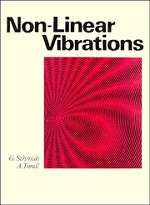Book contents
- Frontmatter
- Preface
- Contents
- Introduction
- 1 Basic properties and definitions
- 2 Methods of solution
- 3 Auxiliary curves for analysis of non-linear systems
- 4 Analysis in the phase plane
- 5 Forced, parametric and self-excited vibrations
- 6 Vibrations of systems with many degrees of freedom
- 7 Investigation of stability in the large
- 8 Analysis of some excited systems
- 9 Quenching of self-excited vibration
- 10 Vibration systems with narrow-band random excitation
- 11 Vibration systems with broad-band random excitation
- 12 Systems with autoparametric coupling
- Appendix
- Bibliography
- Index
- Frontmatter
- Preface
- Contents
- Introduction
- 1 Basic properties and definitions
- 2 Methods of solution
- 3 Auxiliary curves for analysis of non-linear systems
- 4 Analysis in the phase plane
- 5 Forced, parametric and self-excited vibrations
- 6 Vibrations of systems with many degrees of freedom
- 7 Investigation of stability in the large
- 8 Analysis of some excited systems
- 9 Quenching of self-excited vibration
- 10 Vibration systems with narrow-band random excitation
- 11 Vibration systems with broad-band random excitation
- 12 Systems with autoparametric coupling
- Appendix
- Bibliography
- Index
Summary
Finding examples for vibrations of systems which are linear is not a trivial matter; there is something in the remark by R. M. Rosenberg that dividing vibrations into linear and non-linear is like dividing the world into bananas and non-bananas. Nevertheless many important vibration problems must be and can be treated in the same way as linear ones, and the book Lineare Schwingungen by Müller and Schiehlen, for instance, is very helpful for all those grappling with vibration problems.
However, numerous vibration phenomena which are theoretically surprising as well as practically important can only be understood on the basis of non-linear vibration. For instance, the wide field of self-excited, parametric and autoparametric vibration, to which we give special consideration in this book, demands non-linear treatment from the very beginning.
The mathematical theory of non-linear vibrations, the numerical and experimental methods for their evaluation and their many applications in mechanics, in mechanical and civil engineering, in physics, electrotechnology, biology and other sciences, have all developed so rapidly of late that it would require many volumes and many specialists to give a comprehensive picture of non-linear vibration.
The difficulties faced by those engaged in the study of the subject are concerned, on the one hand, with the broad scope of problems and the diversity of systems involved, and on the other hand with the fact that some general laws, such as the principle of superposition and the principle of proportionality, which can be used to advantage in solutions of linear systems, do not apply to non-linear ones.
- Type
- Chapter
- Information
- Non-linear Vibrations , pp. 9 - 11Publisher: Cambridge University PressPrint publication year: 1986

